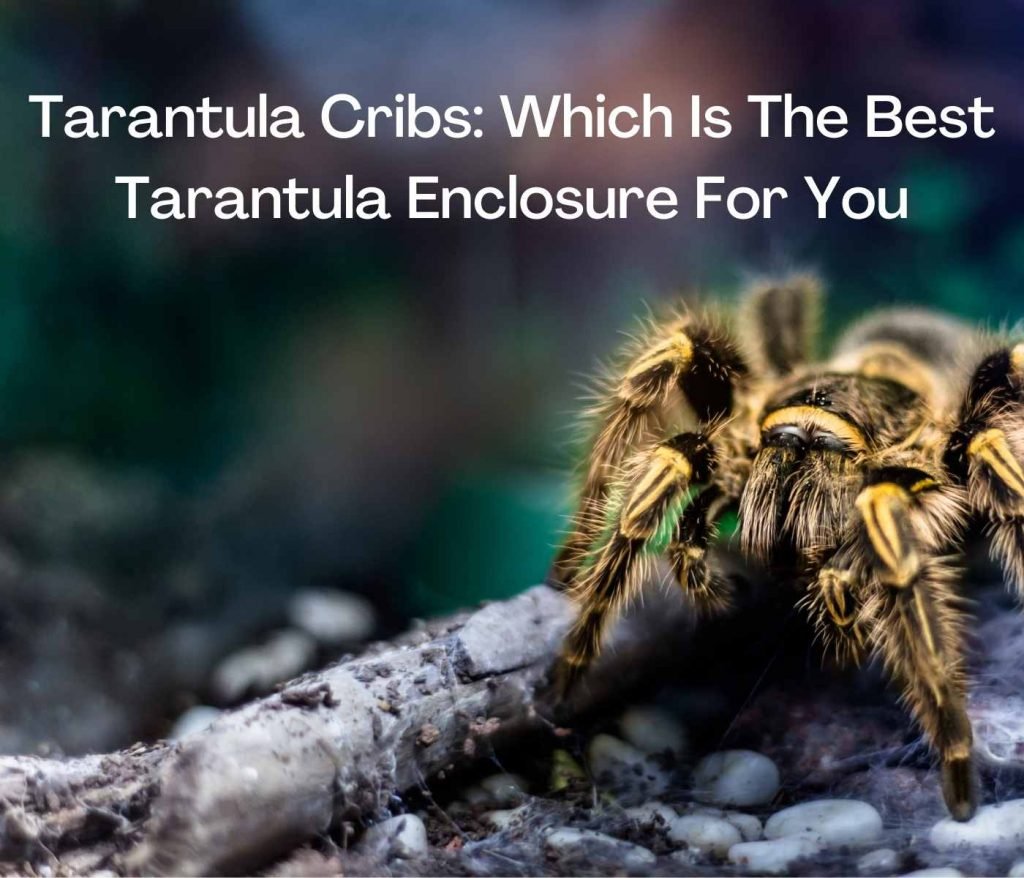After deciding that you want a pet tarantula: the next thing you have to consider is a tarantula enclosure or a crib. Housing your pet spider in the best condition is the only way to keep them happy and thriving. There are all kinds of tarantula cribs out there, so it can be hard to decide which one is right for you and your new pet. Here are some things to consider when choosing a tarantula enclosure:
Things To Consider When Choosing A Tarantula Enclosure
Size: The first thing you need to take into account is the size of your tarantula. Tarantulas come in all different sizes, so you need to make sure that the enclosure you choose is big enough for them to comfortably move around in. If your tarantula is still growing, it’s a good idea to get an enclosure that’s a little bit bigger than they currently are, so they have room to grow into it.
Type of Enclosure: There are all sorts of enclosures out there made specifically for tarantulas, from glass tanks to wooden boxes. It’s important to choose an enclosure that’s made out of a material that won’t harm your tarantula if they happen to come into contact with it.
Location: Another thing to consider is where you’re going to put your tarantula’s enclosure. Tarantulas like it warm and humid, so somewhere like a bathroom or a kitchen might be a good option. Just make sure that the location you choose is out of direct sunlight, as too much heat can be bad for your tarantula.
Ventilation: Tarantulas need fresh air, just like we do! Make sure that the enclosure you choose has some form of ventilation like air holes, so that your tarantula can get the air it needs.

Types Of Tarantula Cribs Available In The Market
Now that you know what to look for in a tarantula enclosure, here are some of the different types of enclosures that are available on the market:
Terrariums: A terrarium is a glass tank that can be used to house all sorts of small animals, including tarantulas. They come in all different shapes and sizes, so you’re sure to find one that’s perfect for your pet spider. One advantage of using a terrarium is that they allow you to create a naturalistic habitat for your tarantula, complete with plants and other decorations.
Aquariums: Aquariums can also be used to house tarantulas, though they’re not as common as terrariums. If you do decide to use an aquarium, make sure that it has a tight-fitting lid, as tarantulas are very good at escaping.
Plastic Boxes: Plastic boxes are another option for housing tarantulas. They’re often cheaper than glass tanks, and they come in a variety of different sizes. Just make sure that the plastic box you choose has ventilation holes, as tarantulas need fresh air to breathe.
Wooden Boxes: Wooden boxes are yet another option for tarantula enclosures. They have the advantage of being very cheap, but the downside is that they’re not as durable as some of the other options on this list.
Tubs: Tubs are often used by tarantula breeders to house large numbers of tarantulas. They’re very cheap, but they’re not the best option if you’re only looking to house one or two spiders.
Cages: Cages are a more expensive option, but they offer a lot of features that the other options on this list don’t. They’re usually made out of metal, so they’re very durable, and they often come with built-in ventilation.
Should You Consider Tarantula Species Before Deciding On A Tarantula Crib?
Yes, you should definitely consider the species of tarantula you’re getting before deciding on an enclosure. Some species of tarantulas are more aggressive than others, and some are more likely to escape from their enclosures. It’s a good idea to do some research on the different types of tarantulas before making your decision.
Here are a few popular tarantula species to help you get started:
The Chilean rose (Grammostola rosea) is a very popular tarantula species that is native to Chile. They’re known for being docile and easy to care for, making them a good choice for beginner tarantula keepers.

The Mexican redknee (Brachypelma hamorii) is another popular tarantula species. They’re native to Mexico, and they’re known for being docile and easy to care for.
The Ecuadorian orange (Pterinopelma aurantiaca) is a beautiful tarantula species that is native to Ecuador. They’re known for being docile, but they can be a bit skittish.
The Brazilian black (Grammostola pulchripes) is a popular tarantula species that is native to Brazil. They’re known for being laid back but very easy to care for.
Once you’ve decided on a few potential species, it’s time to start looking for a tarantula enclosure!
The Most Important Accessories To Have In A Tarantula Enclosure
Here are some of the most important tarantula collective accessories you’ll need to get for your pet spider:
A water dish: A water dish is essential for any tarantula enclosure. Tarantulas need to drink, just like we do! Make sure that the water dish you choose is shallow and wide so that your tarantula can easily access it.
A hide: A hide is a piece of furniture that provides a place for your tarantula to hide away from the light. Tarantulas are nocturnal animals, so they prefer to spend their days in darkness. A hide will give your tarantula a place to feel safe and secure.
Coconut fiber: Coconut fiber is a type of bedding that is often used in tarantula enclosures. It has the advantage of being absorbent, which is important for keeping the enclosure clean.
A heat mat: A heat mat is an electrical device that emits heat. Tarantulas are tropical animals, so they need warmth to survive. A heat mat will help to keep your tarantula’s enclosure warm and comfortable.
Thermometer: A thermometer is a must-have accessory if you’re using a heat mat in your tarantula enclosure. It will help you to monitor the temperature of the enclosure so that you can make sure it’s not too hot or too cold for your tarantula.

Now that you know what to look for in a tarantula enclosure, and what accessories you’ll need to get for your pet spider, you’re ready to start shopping!
Where Can You Buy A Tarantula Enclosure?
Tarantula enclosures are available for purchase from a variety of online retailers. Here are a few popular options:
- Amazon
- eBay
- Reptile Stores
- Pet stores
If you’re looking for a more custom solution, you can also have an enclosure built to your specifications by a professional reptile cage builder.
How Much Should You Spend On A Tarantula Crib?
The cost of a tarantula enclosure will vary depending on the size and features you’re looking for. A simple plastic enclosure can cost as little as $20, while a more elaborate wooden enclosure can cost upwards of $100.
As a general rule, it’s best to spend as much as you can afford on your tarantula enclosure. A high-quality enclosure will last longer and provide a better environment for your pet spider.
What Are The Best Tarantula Cribs?
Here are some of the best tarantula enclosures on the market:
Exo Terra Glass Terrarium: This terrarium is made from glass, so it’s durable and stylish. It includes a front-opening door for easy access, and it comes with a mesh top to keep your tarantula in and pests out.
Zoo Med Naturalistic Terrarium: This terrarium is made from glass, so it’s durable and stylish. It includes a front-opening door for easy access, and it comes with a mesh top to keep your tarantula in and pests out.
Repti Zoo Glass Reptile Terrarium: This terrarium is made from glass, so it’s durable and stylish. It includes two front-opening doors for easy access, and it comes with a mesh top to keep your tarantula in and pests out.
How Do You Maintain Tarantula Enclosures?
Tarantula enclosures require very little maintenance. The most important thing you can do for your pet spider is to keep the enclosure clean. This means removing any dead insects or other food items that your tarantula doesn’t eat.
You should also periodically check the water dish to make sure it’s full, and empty it out if it becomes dirty.
Finally, you should inspect the enclosure regularly for any signs of damage or escape routes. Tarantulas are expert climbers, so it’s important to make sure that the enclosure is secure.
Where Should You Put Your Tarantula Enclosure?
Tarantulas are tropical animals, so they need warmth to survive. For this reason, it’s important to place your tarantula enclosure in a warm location.
Ideally, the temperature of the room where you keep your tarantula should be around 75-80 degrees Fahrenheit during the day, and 60-70 degrees Fahrenheit at night.
You should also place the enclosure away from drafts, direct sunlight, and any other sources of heat or cold.
Your tarantula enclosure doesn’t need to be fancy or expensive. As long as it meets your pet spider’s basic needs, it will be happy and healthy.
DIY Tips To Make A Tarantula Enclosure
If you’re feeling handy, you can save some money by building your own tarantula enclosure. Here are a few tips to get you started:
1. Use a sturdy material that won’t break easily. Glass is a good option, but plastic will work in a pinch.
2. Make sure the enclosure has plenty of ventilation. Tarantulas need fresh air to stay healthy.
3. Create hiding places for your tarantula to feel secure. overturned flower pots, cardboard boxes, and pieces of wood make good hiding spots.
4. Add a water dish for your tarantula to drink from. A small bowl or jar will do the trick.
5. Place the enclosure in a warm location away from drafts.
With a little effort, you can easily build a comfortable home for your pet spider.
What If Your Pet Tarantula Escapes From Its Enclosure?
If your tarantula escapes from its enclosure, don’t panic. Most spiders are harmless and won’t cause any damage.
The best thing to do is to try to find the spider and put it back in its enclosure. If you can’t find the spider, there’s no need to worry. It will likely find its way back home on its own.
A tarantula escape is not a reason to get rid of your pet spider. With a little care and attention, your tarantula will be happy and healthy for many years to come.
How To Make Your Tarantula Crib Escape-Proof

Tarantulas are expert climbers, so it’s important to make sure that their enclosure is escape-proof. Here are a few tips to keep your tarantula where it belongs:
1. Use a material that’s difficult for spiders to climb, such as glass or metal.
2. Make sure the enclosure has a tight-fitting lid. A mesh top is also a good idea.
3. Inspect the enclosure regularly for any signs of damage or escape routes.
4. Place the enclosure in an area that’s not easy to access, such as on a high shelf or in a closet.
By following these simple tips, you can rest assured that your tarantula will stay put.
Conclusion
A good tarantula crib is key to the health and happiness of your pet spider. As alluded to above, it doesn’t need to be fancy and elaborate but should provide for some key needs. These include ventilation, a source of water, hiding spots, and a warm location. If you opt to make your own tarantula enclosure, follow the tips provided. And finally, if your pet spider does escape, don’t fret – they will likely find their way back home on their own. By following these tips, you can easily create a comfortable home for your tarantula.


